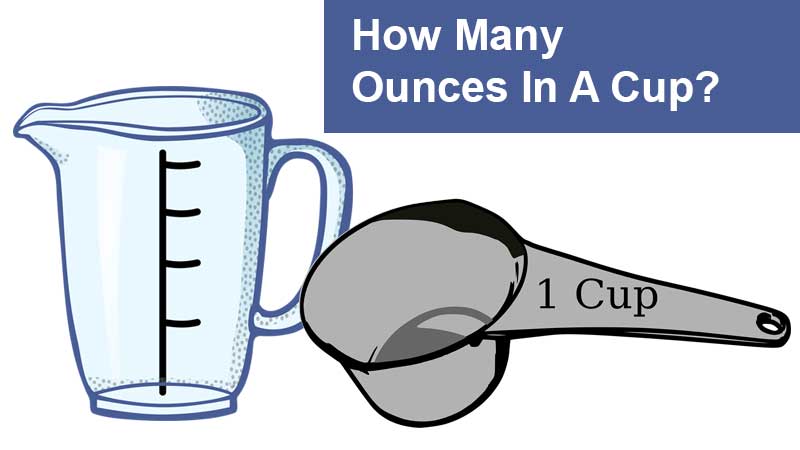How Many Ounces In A Cup?
Getting into the interesting topic, let's know what is Ounce? and how it is classified & measured with variables. And, then to acknowledge more details regarding the ounce measurement & classifications using this blog. Let’s get started!!

What is an Ounce?
An ounce is simply the least unit measurement that can be represented as mass, weight, or volume. It is basically generated and in practice in American Imperial System & British Metric System for many purposes (especially cooking & baking). When it comes to the abbreviation “oz” denotes a unit that is derived from the Italian and Spanish word “Onza.”
With reference to the Ounces origin, it is broadly classified into two different types: namely; the dry ounce and the fluid ounce.
Dry Ounce
A dry ounce is a unit utilized to level or measure small weights of ingredients. For the user's benefit, let’s see some common dry ingredients used to measure or in-practice- they are flour, nuts, seeds, sugar, and in the rare case- honey and yogurt.
To weigh the above-mentioned ingredients, you need a dry measuring cup. Eventually, this might result in different oz values for varied ingredients during the period of converting them into cups.
Fluid Ounce
As a reference to the dry ounce measurement stats, we have the fluid ounce which is used to weigh or measure small volumes.
This word is abbreviated as “fl oz.” We can measure the liquid components like milk, water, or cooking oil to enhance your favorite recipes simply use these measuring cups.
Tip: As it's a liquid type, try to avoid messing up while measuring which may result in invalid or some variations on your measurement.
We have a measurement table for the user's concerns, in turn, to bring the best output on their recipes.
Liquid ingredients
When it comes to liquid or fluid Ounces, the measuring strategy is easy. Liquids are measured in fluid ounces, and you know, there are 8 fluid ounces in 1 cup. In that perceptive, we have listed the measurement below, with reference to the cup.
| 1/8 Cup = 1 Ounce |
| 1/4 Cup = 2 Ounces |
| 1/3 Cup = 2 ½ Ounces |
| 1/2 Cup = 4 Ounces |
| 2/3 Cup = 5 Ounces |
| 1 Cup = 8 Ounces |
| 1 ½ Cups = 12 Ounces |
| 2 Cups = 16 Ounces |
| 2 ½ Cups = 20 Ounces |
| 3 Cups = 24 Ounces |
| 4 Cups = 32 Ounces |
How Many Ounces in a Cup: Measuring Liquid and Dry Ounces?
Hope the above information may give you some relatable requirements needed for measuring the liquid and Dry ingredients. Do you know How many Ounces make a cup? Or how to measure, just proceed below and find the efficient source.
In general, the weight and volume of liquids are similar. On the other hand, when it comes to dry-based ingredients, you will be in trouble and a little more complicated.
Visualize two measuring cups on your kitchen scales which are kept adjacent to each other. Initially, take 8 oz and try to fill the water. On the other hand, take 3 oz and fill with popcorn. Its virtual experiment may give you the variation and result of weighing values for dry & liquid ingredients.
Tip: When you take dry goods like flour, represent them in volume.
In accordance with the above experiment, we know- an ounce is a stable unit of measurement that may be familiar to every kitchen's needs/Measurements. So, to make it simple- don’t get confused or bored by measuring the Ounces in a cup rather enjoy the cooking as well as the measurement phrase of your recipe to add even more delight to your food.
How to fill in a Dry Measuring Cup:
Note: Use the batter knife to level the cup and to weigh perfectly.
- Step 1 – To use the dry measuring cup, try to keep the measuring cup in a bowl you have chosen.
- Step 2 – Simply, pour or fill the dry ingredients gently into the cup.
- Step 3 – If the ingredients seem to touch the brim, you can level it and dust out the excess into the bowl.
- Step 4 – You are ready to measure using a cup or keep it on the scale to weigh.
How to fill in a Wet Measuring Cups
Note: Avoid spilling or messing up the kitchen, by ensuring with pouring edges (Pathway to lid the liquid to flow).
- Step 1: Gently, pour the liquid into the measuring cup.
- Step 2: Eventually, have an eye on the measuring line in turn to track the measurement.
- Step 3: Relax and slowly keep it on the scale to weigh.
To add more delight to your recipe with one common need- Yes, Water is the basic need for all the recipes to bring top-notch output. Let’s see the measurement to make your work dam easier:
How many ounces in a Cup of water?
- 1/4 cup = 2 oz
- 1/3 cup = 2 ½ oz
- 1/2 cup = 4 oz
- 1 cup = 8 oz
Added to this, let’s have a quick glimpse at the international measurements.
What is the internationally recognized standard of measurement?
A Cup is equal to:
- US recipes - cups to ounces
- 1 US cup (236.59mL) = 8 US fluid ounces
- 1 US cup (236.59mL) = 8.327 UK fluid ounces
Old UK recipes - cups to ounces
- 1 UK cup (284.13mL) = 10 UK fluid ounces
- 1 UK cup (284.13mL) = 9.607 US fluid ounces
Rest of world recipes
- 1 international metric cup (250mL) = 8.454 US fluid ounces
- 1 international metric cup (250mL) = 8.799 UK fluid ounces
Related Post